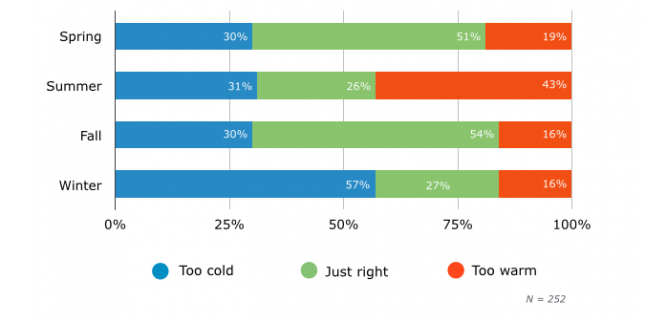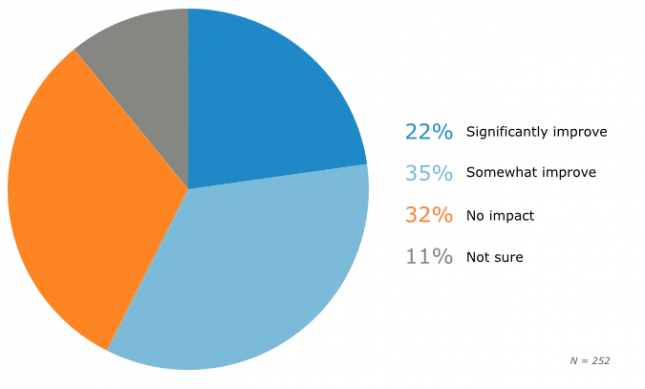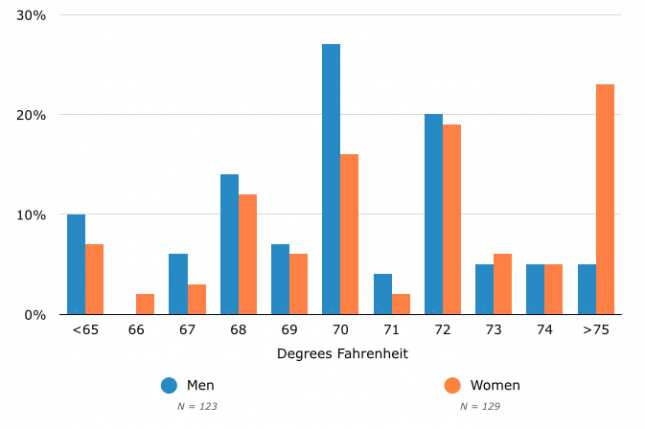Study explores thermostat solutions for businesses
Software Advice, a company that helps software buyers find HVAC software, recently released a report that analyzes the “thermostat wars” that rage in offices across the country every summer: some like it cool, others like it hot, and companies find it nearly impossible to please all their employees. To learn more, Software Advice conducted a survey of office workers to understand employee temperature preferences, which found outdated HVAC technology doesn’t just cost businesses $30,000 annually – it also significantly impacts employee morale and office productivity. Key Findings:
- 50 percent of respondents report being dissatisfied at least several times a month with the temperature of their office.
- 42 percent of respondents say their offices are too warm during the summer, while 56 percent report that their offices are too cold in the winter. Even more staggering, only 26% of employees think their office climate is “just right” in the summer.

- A majority of respondents (60 percent) say that having more control over their office’s temperature would increase their productivity. While employees say having more control over temperature would boost their morale and productivity, it’s important to note there will still need to be compromise between male and female coworkers, which Software Advice found to be a cause of numerous climate disagreements.

- The median preferred office temperature for women is 72 degrees Fahrenheit, compared to 70 degrees Fahrenheit for men.
- Frequency of dissatisfaction with temperature increases with age: 46- to 55-year-old employees are 36 percent more likely to be dissatisfied than 18- to 25-year-olds.
 One of these new systems, Comfy, integrates with an office’s heating, ventilation and air conditioning (HVAC) system. It allows employees to make requests from their smartphone or Web browser to have the office space warmed or cooled. The catch? While it gives employees a degree (pardon the pun) of control, Comfy limits blasts of warm or cool air to 10 minutes long.
Another option, Google-backed startup Nest, offers another type of “smart” thermostat. While it does not have the “voting” capabilities that Comfy offers, Nest can also intelligently detect usage patterns in an office and regulate temperatures automatically. While employees would still have to be given access to the thermostat with Nest, this is easily achievable through smartphone app and Web-browser controls.
Though Nest is primarily used in residential spaces and smaller offices, there are several “smart” thermostat companies that target large commercial buildings. Network Thermostats, for example, offers WiFi enabled thermostats that can also be controlled from smartphone apps and Web browsers.
With these more advanced climate-control systems, sensors can be placed throughout a building to provide more accurate temperature data. With this data at hand, employees could theoretically determine where the most comfortable spot in the office is for them.
Overall, the issue of climate can be addressed if companies consider these three things:
One of these new systems, Comfy, integrates with an office’s heating, ventilation and air conditioning (HVAC) system. It allows employees to make requests from their smartphone or Web browser to have the office space warmed or cooled. The catch? While it gives employees a degree (pardon the pun) of control, Comfy limits blasts of warm or cool air to 10 minutes long.
Another option, Google-backed startup Nest, offers another type of “smart” thermostat. While it does not have the “voting” capabilities that Comfy offers, Nest can also intelligently detect usage patterns in an office and regulate temperatures automatically. While employees would still have to be given access to the thermostat with Nest, this is easily achievable through smartphone app and Web-browser controls.
Though Nest is primarily used in residential spaces and smaller offices, there are several “smart” thermostat companies that target large commercial buildings. Network Thermostats, for example, offers WiFi enabled thermostats that can also be controlled from smartphone apps and Web browsers.
With these more advanced climate-control systems, sensors can be placed throughout a building to provide more accurate temperature data. With this data at hand, employees could theoretically determine where the most comfortable spot in the office is for them.
Overall, the issue of climate can be addressed if companies consider these three things:
- Determine what your employees want. Consider sending out an anonymous online poll or survey to determine what your employee temperature preferences actually are.
- Evaluate new software and technology solutions. There is often a business case for revamping your office’s thermostat controls beyond making employees more comfortable: Wasted energy to heat or cool a building is wasted money.
- Consider alternative solutions. Even with the “smartest” technology, disagreements can still occur, leaving some employees unhappy. Encourage your staff to speak up if they’re uncomfortable, and see if you can relocate them to a different part of the office.
